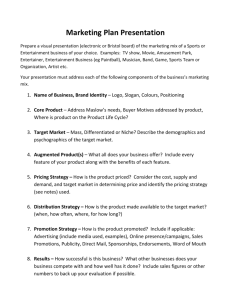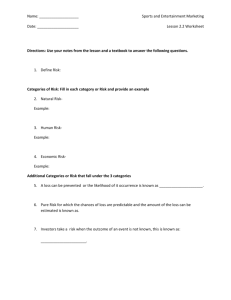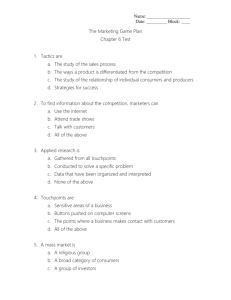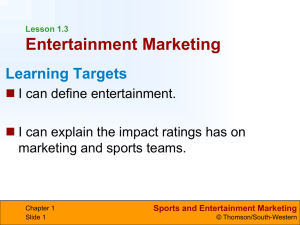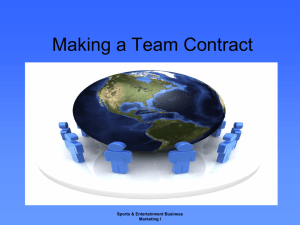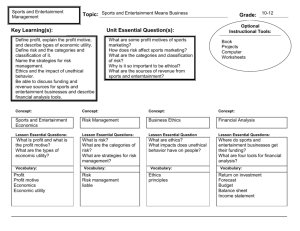Sports and Entertainment Marketing
advertisement
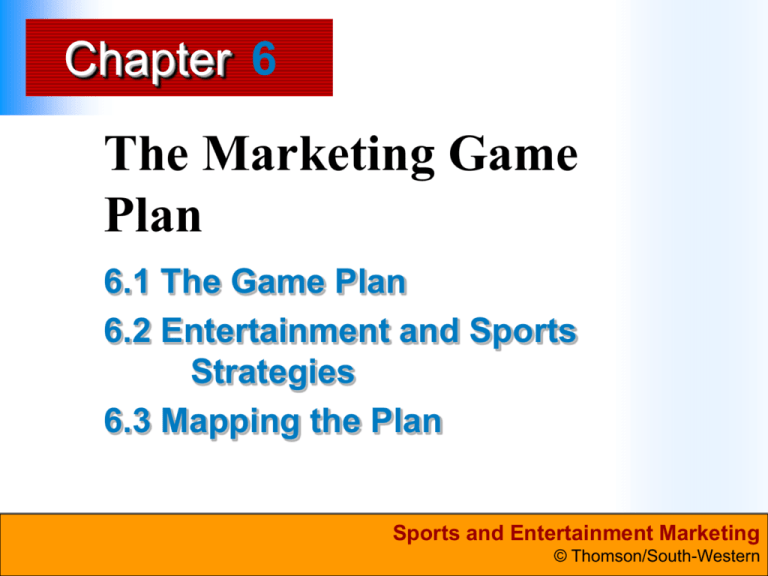
Chapter 6 The Marketing Game Plan 6.1 The Game Plan 6.2 Entertainment and Sports Strategies 6.3 Mapping the Plan Sports and Entertainment Marketing © Thomson/South-Western Winning Strategies George Mason University - 2006 Cinderella team changed the way the nation looked at the university Prior to the tournament, George Mason was a relatively unknown university with multiple locations near Washington D.C. The men’s basketball team went to the Final Four for the first time in school history Chapter 6 Slide 2 Sports and Entertainment Marketing © Thomson/South-Western Impact George Mason saw 54% increase in out-of-state applications. Bookstore sold $800,000 in merchandise in March, 2006. They sold $625,000 the rest of the year 25% increase in annual giving campaign Chapter 6 Slide 3 Sports and Entertainment Marketing © Thomson/South-Western Winning Strategies VCU – Final Four 2011 Bookstore sold $1.3m in merchandise during March, 2011. They did $800,000 the entire year of 2010 Athletic donations increased 376% Overall donations increased 46% Chapter 6 Slide 4 Sports and Entertainment Marketing © Thomson/South-Western Winning Strategies Florida Gulf Coast 2013 Bookstore sales increased 1,240% for men’s merchandise and 786% for women’s merchandise Visitors to admissions website went from 2,280 to 42,793 Chapter 6 Slide 5 Sports and Entertainment Marketing © Thomson/South-Western Lesson 6.1 The Game Plan Goals Explain the difference between marketing tactics and strategies. Discuss the importance of planning to stay ahead of the competition. Chapter 6 Slide 6 Sports and Entertainment Marketing © Thomson/South-Western MARKETING TACTICS Nike wants to be number one in their market. Nike needs to differentiate itself from Adidas, the market leader. Chapter 6 Slide 8 Sports and Entertainment Marketing © Thomson/South-Western Tactics First tactic the way a product or service is differentiated in the minds of customers from other competing products or services the most effective tactics are developed by salespeople tactics can work their way from salespeople to upper management Chapter 6 Slide 9 Sports and Entertainment Marketing © Thomson/South-Western Strategies strategies the process by which tactics are implemented Chapter 6 Slide 10 Sports and Entertainment Marketing © Thomson/South-Western What is the difference between a tactic and a strategy? Chapter 6 Slide 11 Sports and Entertainment Marketing © Thomson/South-Western BEATING THE COMPETITION “Winning the game” in business means gaining market share over competitors and making a profit. requires depth of competitive knowledge Chapter 6 Slide 12 Sports and Entertainment Marketing © Thomson/South-Western What Information is Needed? marketing intelligence information gathered about competitors Chapter 6 Slide 13 Sports and Entertainment Marketing © Thomson/South-Western Pricing pricing is very important to customers the prices of competitors can influence buying decisions Chapter 6 Slide 14 Sports and Entertainment Marketing © Thomson/South-Western Distribution marketers need to make the product purchase convenient for customers Chapter 6 Slide 15 Sports and Entertainment Marketing © Thomson/South-Western Product/Service Management knowing the product and service offerings of competitors can help a business determine how to differentiate its products Chapter 6 Slide 16 Sports and Entertainment Marketing © Thomson/South-Western Promotional Efforts promotional competitive analysis reveals: the product characteristics emphasized by competitors target customers promotional budgets Chapter 6 Slide 17 Sports and Entertainment Marketing © Thomson/South-Western Finding the Information Marketing information is critical to help anticipate future moves of the competition. Chapter 6 Slide 18 Sports and Entertainment Marketing © Thomson/South-Western observations combining the insights of a variety of salespeople can provide valuable competitive information Chapter 6 Slide 20 Sports and Entertainment Marketing © Thomson/South-Western trade shows major events where people in a related industry meet to show their products exchange ideas learn about the latest trends valuable source of competitive information Chapter 6 Slide 21 Sports and Entertainment Marketing © Thomson/South-Western customers customer feedback is critical for fine tuning marketing plans can provide competitive information Chapter 6 Slide 22 Sports and Entertainment Marketing © Thomson/South-Western Give three examples of marketing intelligence information that might be collected by a movie theater. Chapter 6 Slide 23 Sports and Entertainment Marketing © Thomson/South-Western Lesson 6.2 Entertainment and Sports Strategies Goals Explain the importance of learning from customers. Discuss sports marketing strategies. Discuss entertainment marketing strategies. Chapter 6 Slide 24 Sports and Entertainment Marketing © Thomson/South-Western DATA-DRIVEN DECISIONS marketing plan the document that describes the tactics and strategies that will be used to market the event, promotion, etc. Chapter 6 Slide 26 Sports and Entertainment Marketing © Thomson/South-Western raw data the facts and recorded measures that have been gathered Chapter 6 Slide 27 Sports and Entertainment Marketing © Thomson/South-Western Interpretation interpretation explaining the information so that it has meaning drawing conclusions that relate to the defined marketing research problem Chapter 6 Slide 28 Sports and Entertainment Marketing © Thomson/South-Western Applied Research applied research conducted to solve specific problems touchpoints the points at which the business makes contact with the customers Chapter 6 Slide 29 web site visits e-mails phone calls advertisements one-on-one sales pitches personal visits Sports and Entertainment Marketing © Thomson/South-Western SPORTS MARKETING STRATEGIES Fans are necessary for the longevity of a team. Using research to form the right tactics to attract fans is a challenge for teams. Chapter 6 Slide 31 Sports and Entertainment Marketing © Thomson/South-Western SPORTS MARKETING STRATEGIES Tier Pricing Many sports now offer tier pricing for games. NY Mets – Dodgers $13, Phillies $20, Yankees $53 Sabres – Gold ($64-185), Silver ($53-146), Bronze ($39-$127) Chapter 6 Slide 32 Sports and Entertainment Marketing © Thomson/South-Western Fans Rule Competition for fans is fierce. Adidas and Nike have different tactics and strategies to compete for soccer fans. Adidas provides soccer balls for the World Cup and promotes customizable soccer cleats. Nike is filling a niche for street-ready soccer merchandise and is sponsoring a number of major international soccer teams. Chapter 6 Slide 33 Sports and Entertainment Marketing © Thomson/South-Western ENTERTAINMENT MARKETING STRATEGIES The movie and music industries use many of the same strategies used in sports marketing to attract customers. Determining the new tactic first and then figuring the strategies that will drive sales is the key. Chapter 6 Slide 35 Sports and Entertainment Marketing © Thomson/South-Western Capitalizing on Controversy Sony carefully developed a tactic and a strategy for promoting The DaVinci Code. provided a website for religious dialogue avoided overexposure prior to the movie’s release Chapter 6 Slide 36 Sports and Entertainment Marketing © Thomson/South-Western Concert Pricing Strategies Indoor concerts are more economical to produce than outdoor concerts. A smaller indoor concert may be more profitable than a larger outdoor concert. Chapter 6 Slide 37 Sports and Entertainment Marketing © Thomson/South-Western Industry consolidation has lead to decreased competition. Declining profits are prompting concert promoters to re-evaluate pricing strategies. Different entertainers can command different amounts of money. Chapter 6 Slide 38 Sports and Entertainment Marketing © Thomson/South-Western A Little Music with Your Coffee? Starbuck’s Entertainment connects Starbuck’s brand with entertainment By 2005, Starbucks sold 3.5 million CDs. Chapter 6 Slide 39 Sports and Entertainment Marketing © Thomson/South-Western Lesson 6.3 Mapping the Plan Goals Explain how marketers determine direction and focus for a marketing plan. List and describe the components of a marketing plan. Chapter 6 Slide 41 Sports and Entertainment Marketing © Thomson/South-Western KNOW WHERE YOU ARE HEADED mission statement identifies the nature of the business and the reason it exists All tactics and strategies should be built around the mission statement. Chapter 6 Slide 43 Sports and Entertainment Marketing © Thomson/South-Western A Sense of Direction mass market a broad group of customers Chapter 6 Slide 44 Sports and Entertainment Marketing © Thomson/South-Western product portfolio all the products a company has available at any one time test marketing where the sales potential for a new product is tried in a small market prior to its final release Chapter 6 Slide 45 Sports and Entertainment Marketing © Thomson/South-Western THE PLAN The marketing plan is a detailed document that further provides a detailed description of how the tactics and strategies will be implemented. Chapter 6 Slide 47 Sports and Entertainment Marketing © Thomson/South-Western Components of a Marketing Plan A marketing plan should be guided by the current and future needs of customers. Chapter 6 Slide 48 Sports and Entertainment Marketing © Thomson/South-Western Analysis The Mission Statement The marketing plan must be in agreement with the mission statement. Marketing Information Information is gathered, analyzed, interpreted and used to make business decisions. Chapter 6 Slide 49 Sports and Entertainment Marketing © Thomson/South-Western The Tactic describes product or service differentiation should pinpoint a gap that is not be filled by another product or service Chapter 6 Slide 50 Sports and Entertainment Marketing © Thomson/South-Western Strategy describes the marketing mix Product/Service the identified need is the basis for the development of the product or service Chapter 6 Slide 51 Sports and Entertainment Marketing © Thomson/South-Western The Distribution System describes how the product or service will be made available to customers Chapter 6 Slide 52 Sports and Entertainment Marketing © Thomson/South-Western Pricing The price must be set where revenues will be maximized to cover all costs and provide a profit. Chapter 6 Slide 53 Sports and Entertainment Marketing © Thomson/South-Western Promotional Strategies how the product will be positioned in the minds of customers Chapter 6 Slide 54 advertising publicity sales promotion personal selling Sports and Entertainment Marketing © Thomson/South-Western Financing disclosure of all expected costs and revenues might indicate need for additional funding Risk Management outlines possible risks and strategies for minimizing the risks Chapter 6 Slide 55 Sports and Entertainment Marketing © Thomson/South-Western Implementation Timeline start with completion date and plan backwards specify event sequencing Assignments of Responsibility specify who is responsible for each component of the plan Internal Communication System define how all key organizational members will be kept informed of the plan provide a feedback mechanism Chapter 6 Slide 56 Sports and Entertainment Marketing © Thomson/South-Western Selling defines how direct sales will be handled Review and Evaluation define mileposts for progress checks of the plan Chapter 6 Slide 57 Sports and Entertainment Marketing © Thomson/South-Western Look to the Future Organizations should have future products planned while current products are still experiencing strong sales. Marketing plans require periodic revisions. Chapter 6 Slide 58 Sports and Entertainment Marketing © Thomson/South-Western PERFORMANCE INDICATORS EVALUATED Develop a written business plan for a startup business. Identify the customer base and demographics for the target market. Demonstrate knowledge and understanding of entrepreneurship. Chapter 6 Slide 60 Sports and Entertainment Marketing © Thomson/South-Western
